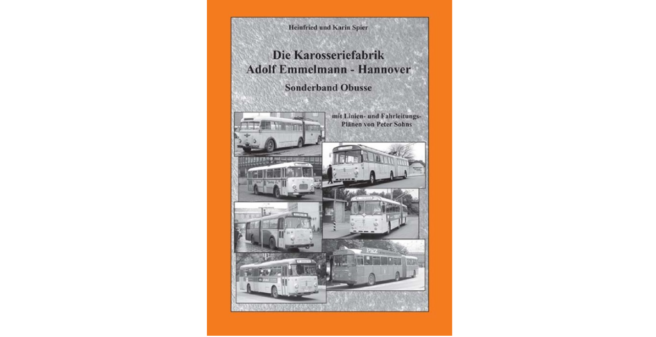
In a fourth book about the bodywork factory, which has been declared a special volume, the authors devote themselves to the trolleybuses that the manufacturer bodyworked. It was only a small step from bus to trolleybus, and the third partner was an electrical company, which equipped the vehicle so that it travelled almost silently by means of two pantograph poles drawing power from a double-pole overhead line.
Emmelmann was able to gain its first experience with this means of transport in 1947 when it was commissioned by the local transport company to restore a war-damaged articulated trolley from Italy to running order. From the beginning of the 1950s, there was a boom in the construction of trolleybus systems, for which a large number of vehicles were required, so that Emmelmann also started building trolleybus bodies and quickly made a good name for itself. As with the diesel vehicles, the vehicles were characterised by an elegant appearance and a comfortable interior. Both two-axle and articulated vehicles were built. They were mostly built on Büssing chassis from Braunschweig and therefore also featured the typical radiator grille, although from the end of the 1950s (the trolleybus was already threatening to become a discontinued model again) a certain uniformity was emphasised for cost reasons. The last two articulated trolleybuses were built in 1966, and in 1965 the only foreign order was landed with Lucerne in Switzerland. The durable and solid Emmelmann articulated trolleybuses were also very popular with the remaining companies and thus also reached the Mürztaler Verkehrsbetriebe in Styria, Austria.
In the usual detailed form, this volume presents all 44 Emmelmann trolleybuses ever built in words and pictures. This is divided into eight chapters according to the respective operating companies, with the second-hand trade also being documented. The cartographer Peter Sohns provided his detailed route and catenary plans for the book, which had previously been published in an atlas and which provide a good overview of the area of operation and enable the photos to be assigned to the respective locations. The half-page and full-page photos come from numerous collections of trolleybus enthusiasts in Germany and abroad and are neatly printed and annotated in detail. There are no colour illustrations, but this does not detract from the value of the publication. Extensive lists of literature, sources, picture credits and a glossary round off the 148-page text and picture section. Another “highlight” is the 24-page appendix with numerous documents, drawings and correspondence with a huge amount of detail and thousands of data on the vehicles built.
For the friend of the trolleybuses, the new publication is actually indispensable. The quality of the content and the quality of the publication provide a very favourable price/performance ratio.
Authors: Heinfried and Karin Spier
200 pages, format: 21.0 x 30.0 cm, hardcover
Publisher: Linus Wittlich KG/Geiger-Verlag
Price: 29,80 €
ISBN: 978 3865957788
17.11.2023
